Abstract
OBJECTIVE: Since controversy exists over whether erythropoietin levels are increased or decreased after thermal injury, a prospective study was performed to answer this question as well as to characterize the erythropoietic response to thermal injury. SUMMARY BACKGROUND DATA: The concept of using erythropoietin to reduce the need for blood transfusions after thermal injury is attractive. However, since the etiology of burn anemia is both unclear and multifocal, prior to initiating a trial of erythropoietin therapy, it will be necessary to better define the erythropoietic response to thermal injury. METHODS: Twenty-four burn patients with a mean burn size of 31 +/- 18% had serial measurements of serum iron, total iron binding capacity (TIBC), ferritin, erythropoietin, transferrin saturation, hemoglobin, and reticulocyte counts performed on burn days 1, 3, 5, 7, 10, 14, and then weekly. RESULTS: The erythropoietic response was characterized by a decrease in hemoglobin levels as well as serum iron, TIBC, and transferrin saturation (p < 0.05). Ferritin and erythropoietin levels increased as did the reticulocyte count. The erythropoietin response to anemia appeared to be at least grossly intact, since there was an appropriate inverse relationship between the degree of anemia and the magnitude of the erythropoietin response (r2 = .61, p < 0.00001). CONCLUSIONS: Since the erythropoietin levels of these anemic burn victims reached supranormal levels and they manifested a moderate reticulocytosis, the role of replacement erythropoietin therapy after thermal injury requires further study.
Full text
PDF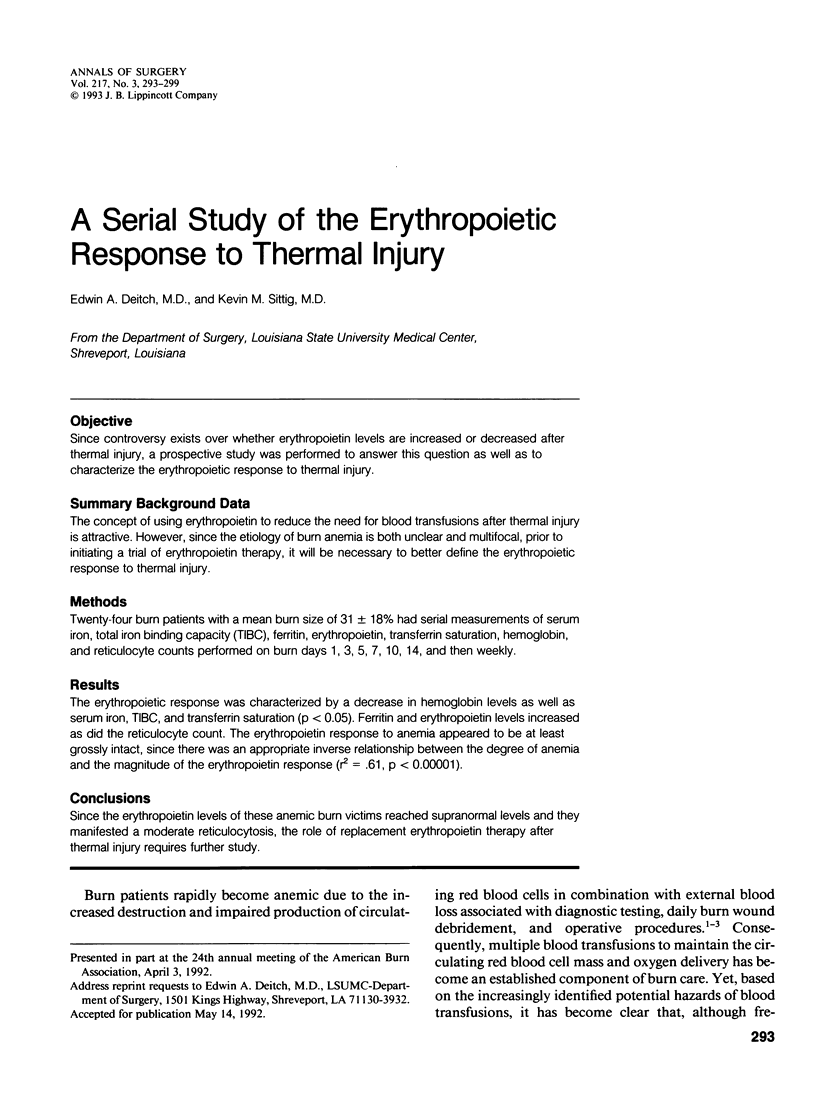
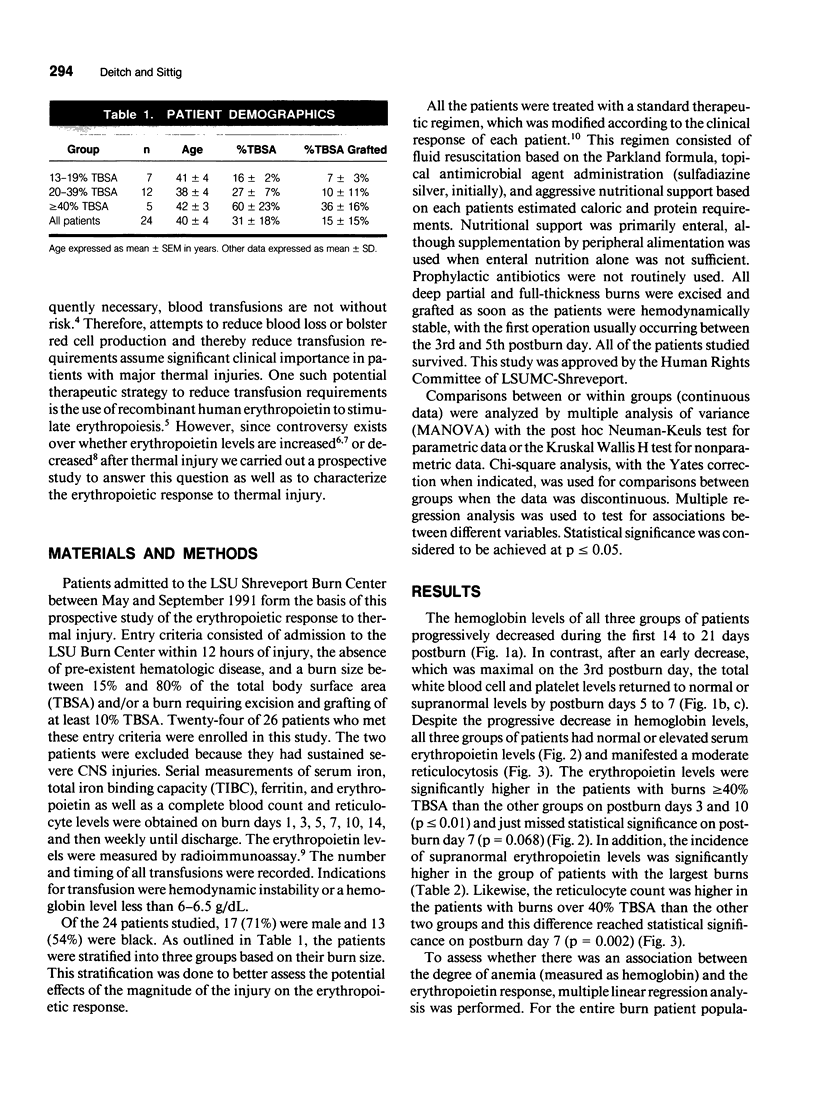
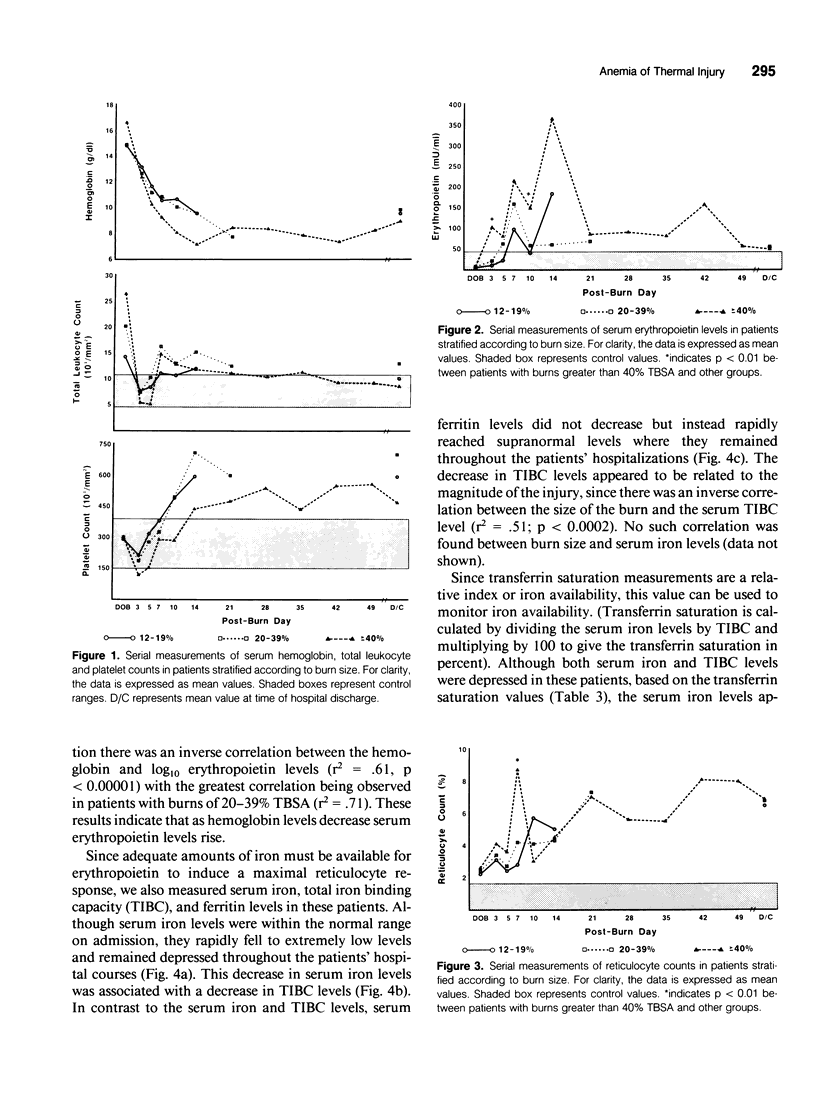
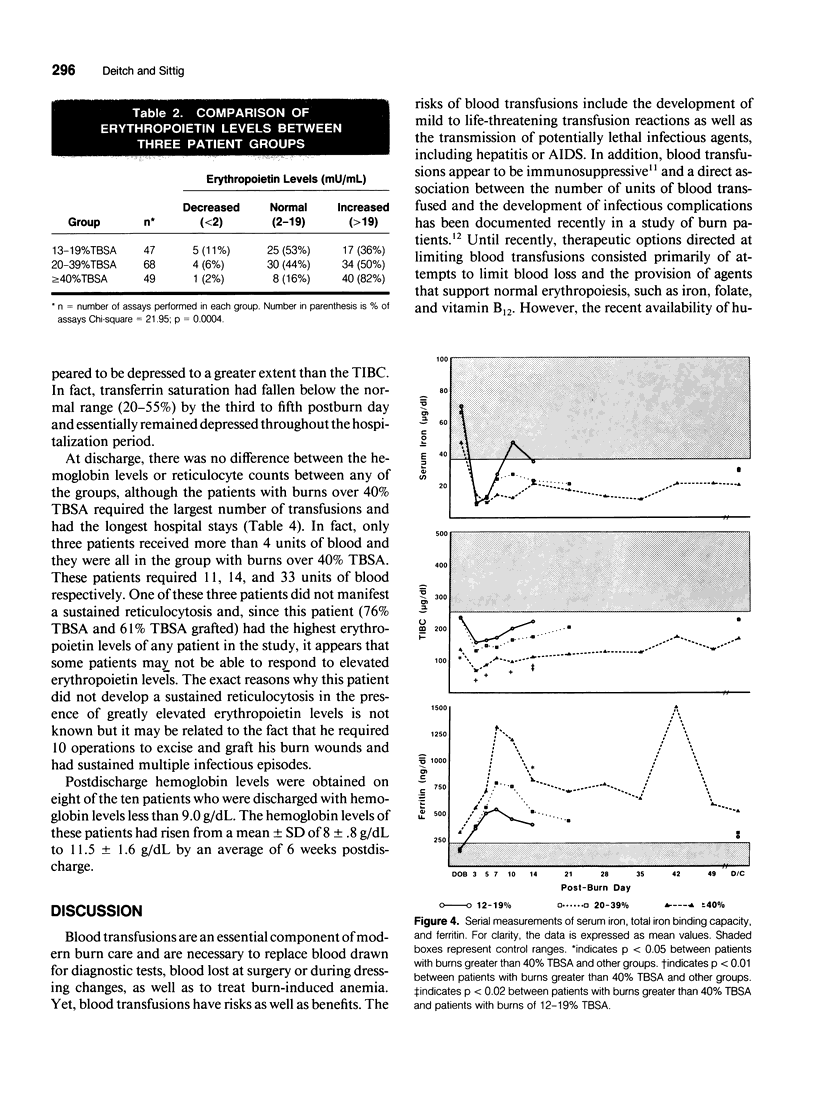
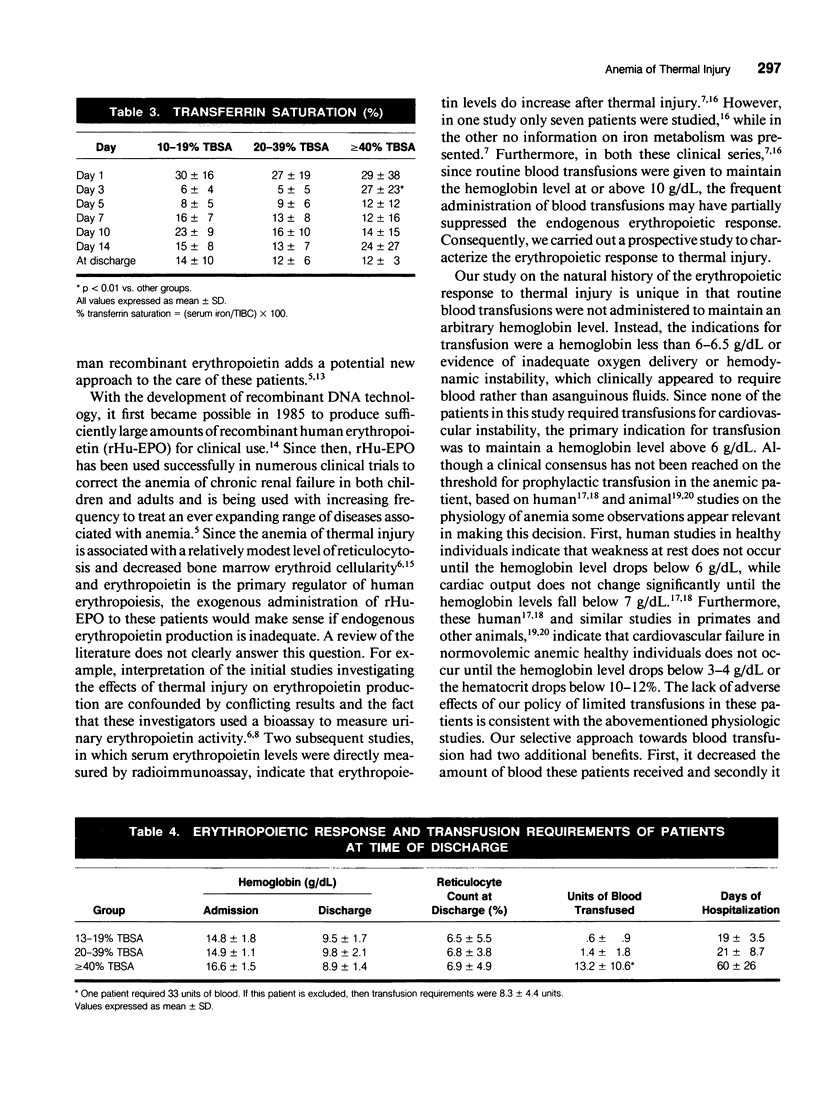
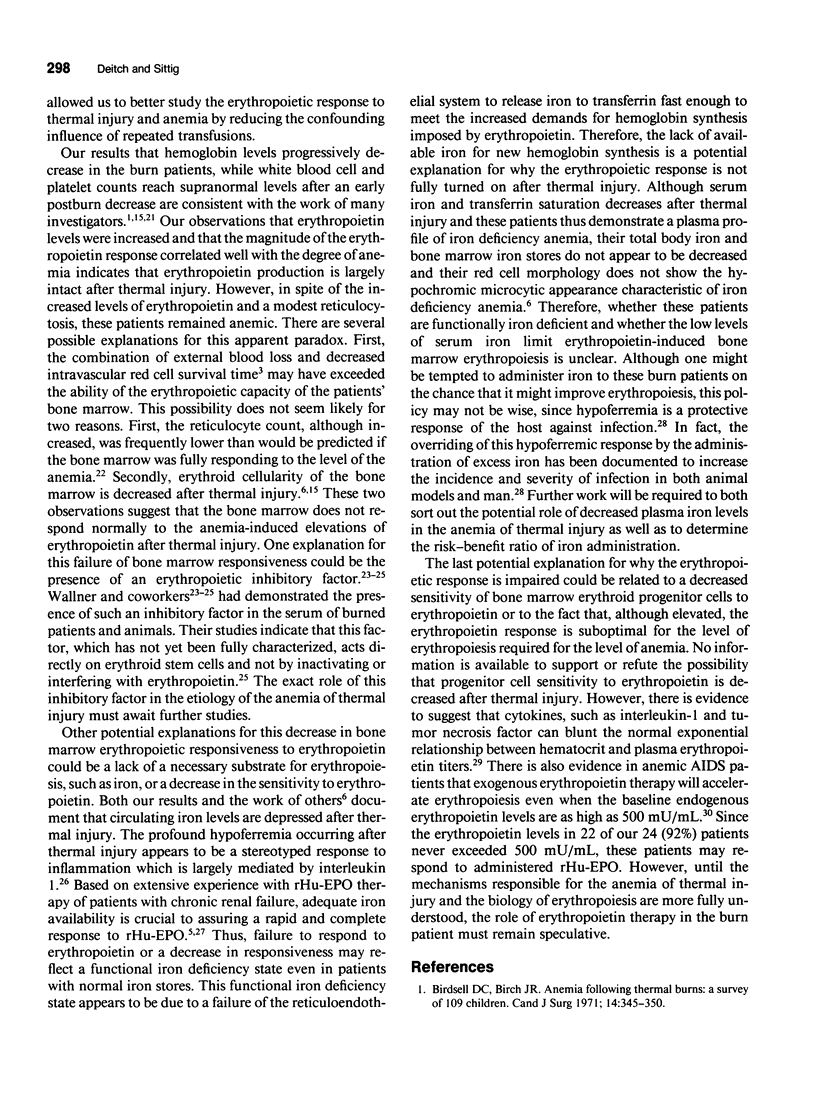

Selected References
These references are in PubMed. This may not be the complete list of references from this article.
- Andes W. A., Rogers P. W., Beason J. W., Pruitt B. A., Jr The erythropoietin response to the anemia of thermal injury. J Lab Clin Med. 1976 Oct;88(4):584–592. [PubMed] [Google Scholar]
- Birdsell D. C., Birch J. R. Anemia following thermal burns: a survey of 109 children. Can J Surg. 1971 Sep;14(5):345–350. [PubMed] [Google Scholar]
- Cain S. M. Oxygen delivery and uptake in dogs during anemic and hypoxic hypoxia. J Appl Physiol Respir Environ Exerc Physiol. 1977 Feb;42(2):228–234. doi: 10.1152/jappl.1977.42.2.228. [DOI] [PubMed] [Google Scholar]
- Desai M. H., Herndon D. N., Broemeling L., Barrow R. E., Nichols R. J., Jr, Rutan R. L. Early burn wound excision significantly reduces blood loss. Ann Surg. 1990 Jun;211(6):753–762. doi: 10.1097/00000658-199006000-00015. [DOI] [PMC free article] [PubMed] [Google Scholar]
- Dinarello C. A. Interleukin-1 and its biologically related cytokines. Adv Immunol. 1989;44:153–205. doi: 10.1016/s0065-2776(08)60642-2. [DOI] [PubMed] [Google Scholar]
- Erslev A. J. Erythropoietin. N Engl J Med. 1991 May 9;324(19):1339–1344. doi: 10.1056/NEJM199105093241907. [DOI] [PubMed] [Google Scholar]
- Fischl M., Galpin J. E., Levine J. D., Groopman J. E., Henry D. H., Kennedy P., Miles S., Robbins W., Starrett B., Zalusky R. Recombinant human erythropoietin for patients with AIDS treated with zidovudine. N Engl J Med. 1990 May 24;322(21):1488–1493. doi: 10.1056/NEJM199005243222103. [DOI] [PubMed] [Google Scholar]
- Garcia J. F., Ebbe S. N., Hollander L., Cutting H. O., Miller M. E., Cronkite E. P. Radioimmunoassay of erythropoietin: circulating levels in normal and polycythemic human beings. J Lab Clin Med. 1982 May;99(5):624–635. [PubMed] [Google Scholar]
- Graves T. A., Cioffi W. G., Mason A. D., Jr, McManus W. F., Pruitt B. A., Jr Relationship of transfusion and infection in a burn population. J Trauma. 1989 Jul;29(7):948–954. doi: 10.1097/00005373-198907000-00007. [DOI] [PubMed] [Google Scholar]
- Jacobs K., Shoemaker C., Rudersdorf R., Neill S. D., Kaufman R. J., Mufson A., Seehra J., Jones S. S., Hewick R., Fritsch E. F. Isolation and characterization of genomic and cDNA clones of human erythropoietin. 1985 Feb 28-Mar 6Nature. 313(6005):806–810. doi: 10.1038/313806a0. [DOI] [PubMed] [Google Scholar]
- Jelkmann W., Wolff M., Fandrey J. Modulation of the production of erythropoietin by cytokines: in vitro studies and their clinical implications. Contrib Nephrol. 1990;87:68–77. doi: 10.1159/000419481. [DOI] [PubMed] [Google Scholar]
- Letendre E. D. Iron metabolism during infection and neoplasia. Cancer Metastasis Rev. 1987;6(1):41–53. doi: 10.1007/BF00047608. [DOI] [PubMed] [Google Scholar]
- Levine E., Rosen A., Sehgal L., Gould S., Sehgal H., Moss G. Physiologic effects of acute anemia: implications for a reduced transfusion trigger. Transfusion. 1990 Jan;30(1):11–14. doi: 10.1046/j.1537-2995.1990.30190117621.x. [DOI] [PubMed] [Google Scholar]
- Linman J. W. Physiologic and pathophysiologic effects of anemia. N Engl J Med. 1968 Oct 10;279(15):812–818. doi: 10.1056/NEJM196810102791508. [DOI] [PubMed] [Google Scholar]
- Loebl E. C., Marvin J. A., Curreri W., Baxter C. R. Erythrocyte survival following thermal injury. J Surg Res. 1974 Feb;16(2):96–101. doi: 10.1016/0022-4804(74)90016-x. [DOI] [PubMed] [Google Scholar]
- McDonald W. S., Sharp C. W., Jr, Deitch E. A. Immediate enteral feeding in burn patients is safe and effective. Ann Surg. 1991 Feb;213(2):177–183. doi: 10.1097/00000658-199102000-00013. [DOI] [PMC free article] [PubMed] [Google Scholar]
- Robinson H., Monafo W. W., Saver S. M., Gallagher N. I. The role of erythropoietin in the anemia of thermal injury. Ann Surg. 1973 Nov;178(5):565–572. doi: 10.1097/00000658-197311000-00002. [DOI] [PMC free article] [PubMed] [Google Scholar]
- Sheldon G. F., Sanders R., Fuchs R., Garcia J., Schooley J. Metabolism, oxygen transport, and erythropoietin synthesis in the anemia of thermal injury. Am J Surg. 1978 Mar;135(3):406–411. doi: 10.1016/0002-9610(78)90075-2. [DOI] [PubMed] [Google Scholar]
- Van Wyck D. B., Stivelman J. C., Ruiz J., Kirlin L. F., Katz M. A., Ogden D. A. Iron status in patients receiving erythropoietin for dialysis-associated anemia. Kidney Int. 1989 Feb;35(2):712–716. doi: 10.1038/ki.1989.43. [DOI] [PubMed] [Google Scholar]
- Varat M. A., Adolph R. J., Fowler N. O. Cardiovascular effects of anemia. Am Heart J. 1972 Mar;83(3):415–426. doi: 10.1016/0002-8703(72)90445-0. [DOI] [PubMed] [Google Scholar]
- Vasko S. D., Burdge J. J., Ruberg R. L., Verghese A. S. Evaluation of erythropoietin levels in the anemia of thermal injury. J Burn Care Rehabil. 1991 Sep-Oct;12(5):437–441. doi: 10.1097/00004630-199109000-00008. [DOI] [PubMed] [Google Scholar]
- Wallner S. F., Vautrin R. M., Buerk C., Robinson W. A., Peterson V. M. The anemia of thermal injury: studies of erythropoiesis in vitro. J Trauma. 1982 Sep;22(9):774–780. doi: 10.1097/00005373-198209000-00010. [DOI] [PubMed] [Google Scholar]
- Wallner S. F., Vautrin R. The anemia of thermal injury: mechanism of inhibition of erythropoiesis. Proc Soc Exp Biol Med. 1986 Jan;181(1):144–150. doi: 10.3181/00379727-181-42236. [DOI] [PubMed] [Google Scholar]
- Wallner S. F., Warren G. H. The haematopoietic response to burning: an autopsy study. Burns Incl Therm Inj. 1985 Oct;12(1):22–27. doi: 10.1016/0305-4179(85)90179-2. [DOI] [PubMed] [Google Scholar]
- Wallner S., Vautrin R., Murphy J., Anderson S., Peterson V. The haematopoietic response to burning: studies in an animal model. Burns Incl Therm Inj. 1984 Apr;10(4):236–251. doi: 10.1016/0305-4179(84)90002-0. [DOI] [PubMed] [Google Scholar]


